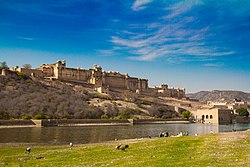Amer Fort
| Amer Fort | |
|---|---|
| Part of Jaipur | |
| Amber, Rajasthan, India | |

Front view of the Palace with serpentine staircase viewing from the road.
|
|
| Coordinates | 26°59′09″N 75°51′03″E / 26.9859°N 75.8507°E |
| Type | Fort and Palace |
| Site information | |
| Controlled by | Government of Rajasthan |
| Open to the public |
Yes |
| Condition | Good |
| Site history | |
| Built | 1592 |
| Built by | Raja Man Singh |
| Materials | Red sandstone and marble |
Amer Fort (Hindi: आमेर क़िला or Amber Fort) is located in Amer, a town with an area of 4 square kilometres (1.5 sq mi) located 11 kilometres (6.8 mi) from Jaipur, Rajasthan state, India. Located high on a hill, it is the principal tourist attraction in the Jaipur area. The town of Amer was originally built by Meenas, and later it was ruled by Raja Man Singh I (December 21, 1550 – July 6, 1614).
Amer Fort is known for its artistic Hindu style elements. With its large ramparts and series of gates and cobbled paths, the fort overlooks Maota Lake. It is the main source of water for the Amer Palace.
Constructed of red sandstone and marble, the attractive, opulent palace is laid out on four levels, each with a courtyard. It consists of the Diwan-i-Aam, or "Hall of Public Audience", the Diwan-i-Khas, or "Hall of Private Audience", the Sheesh Mahal (mirror palace), or Jai Mandir, and the Sukh Niwas where a cool climate is artificially created by winds that blow over a water cascade within the palace. Hence, the Amer Fort is also popularly known as the Amer Palace. The palace was the residence of the Rajput Maharajas and their families. At the entrance to the palace near the fort's Ganesh Gate, there is a temple dedicated to Sila Devi, a goddess of the Chaitanya cult, which was given to Raja Man Singh when he defeated the Raja of Jessore, Bengal in 1604. (Jessore is now in Bangladesh).
This palace, along with Jaigarh Fort, is located immediately above on the Cheel ka Teela (Hill of Eagles) of the same Aravalli range of hills. The palace and Jaigarh Fort are considered one complex, as the two are connected by a subterranean passage. This passage was meant as an escape route in times of war to enable the royal family members and others in the Amer Fort to shift to the more redoubtable Jaigarh Fort.
...
Wikipedia

